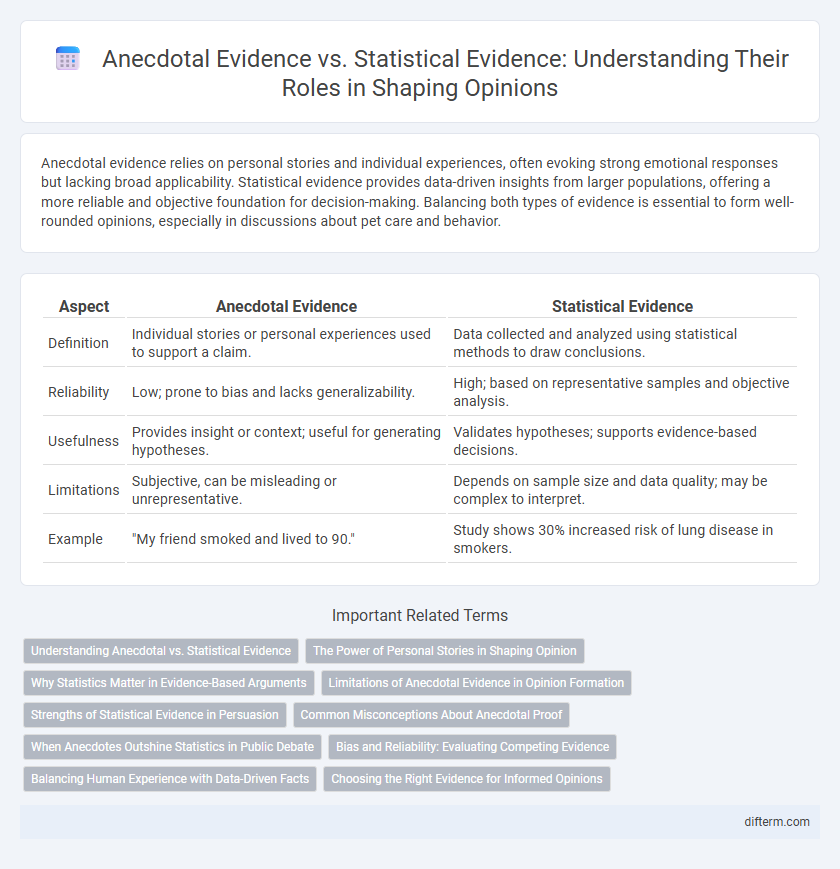Anecdotal evidence relies on personal stories and individual experiences, often evoking strong emotional responses but lacking broad applicability. Statistical evidence provides data-driven insights from larger populations, offering a more reliable and objective foundation for decision-making. Balancing both types of evidence is essential to form well-rounded opinions, especially in discussions about pet care and behavior.
Table of Comparison
| Aspect | Anecdotal Evidence | Statistical Evidence |
|---|---|---|
| Definition | Individual stories or personal experiences used to support a claim. | Data collected and analyzed using statistical methods to draw conclusions. |
| Reliability | Low; prone to bias and lacks generalizability. | High; based on representative samples and objective analysis. |
| Usefulness | Provides insight or context; useful for generating hypotheses. | Validates hypotheses; supports evidence-based decisions. |
| Limitations | Subjective, can be misleading or unrepresentative. | Depends on sample size and data quality; may be complex to interpret. |
| Example | "My friend smoked and lived to 90." | Study shows 30% increased risk of lung disease in smokers. |
Understanding Anecdotal vs. Statistical Evidence
Anecdotal evidence relies on personal stories or isolated examples, often lacking the rigor needed for reliable conclusions, whereas statistical evidence uses aggregated data and systematic analysis to reveal patterns and trends. Understanding the differences between these forms is crucial in evaluating claims accurately, as anecdotal evidence can be persuasive but prone to bias and misinterpretation. Statistical evidence provides a stronger foundation for decision-making by emphasizing empirical validation and reproducibility.
The Power of Personal Stories in Shaping Opinion
Personal stories serve as powerful catalysts in shaping opinions by creating emotional connections that raw statistical evidence often fails to achieve. Anecdotal evidence humanizes abstract data, making complex issues more relatable and memorable to individuals. While statistical evidence provides essential factual grounding, the persuasive impact of personal narratives plays a crucial role in influencing public attitudes and decision-making processes.
Why Statistics Matter in Evidence-Based Arguments
Statistical evidence provides a reliable foundation for arguments by minimizing bias and offering quantifiable data that anecdotal evidence cannot ensure. It allows for generalization across larger populations, increasing the validity and credibility of conclusions drawn. Relying on statistics helps avoid the pitfalls of subjective interpretation and promotes informed decision-making grounded in empirical analysis.
Limitations of Anecdotal Evidence in Opinion Formation
Anecdotal evidence is limited by its reliance on personal experiences, which are often unrepresentative and subject to cognitive biases such as confirmation bias and selective memory. This type of evidence lacks the systematic data collection and analysis present in statistical evidence, making it insufficient for forming reliable, generalizable opinions. Consequently, opinions based solely on anecdotal evidence risk being skewed and misleading due to the absence of robust empirical support.
Strengths of Statistical Evidence in Persuasion
Statistical evidence provides objective, quantifiable data that enhances credibility and supports logical reasoning in persuasion. Its strength lies in representing broader trends beyond individual cases, reducing bias and emotional influence. This type of evidence facilitates clear comparisons and demonstrates consistent patterns, making arguments more convincing and reliable.
Common Misconceptions About Anecdotal Proof
Anecdotal evidence often gets mistaken for reliable proof, yet it lacks the statistical significance needed to establish causal relationships. People frequently overvalue personal stories because they are vivid and relatable, ignoring that these accounts are subject to bias and limited sample size. Understanding the difference between anecdotal and statistical evidence is crucial for forming well-founded opinions and avoiding misleading conclusions.
When Anecdotes Outshine Statistics in Public Debate
Anecdotal evidence often outshines statistical evidence in public debate by providing relatable, vivid stories that resonate emotionally with audiences, making complex data more accessible. Personal narratives can highlight exceptions and human experiences that statistics overlook, fostering empathy and immediate understanding. This emotional connection frequently sways public opinion more effectively than abstract numbers, especially in controversial or morally charged issues.
Bias and Reliability: Evaluating Competing Evidence
Anecdotal evidence often suffers from bias due to its reliance on personal experiences and selective storytelling, which limits its reliability in forming general conclusions. Statistical evidence, by contrast, uses systematic data collection and analysis to minimize bias, offering a more robust and objective basis for evaluation. Prioritizing statistical evidence enhances decision-making accuracy by reducing the influence of subjective perception and confirmation bias.
Balancing Human Experience with Data-Driven Facts
Balancing human experience with data-driven facts requires recognizing the unique insights anecdotal evidence offers, especially in understanding individual perspectives and contexts that raw data might overlook. Statistical evidence provides broad, generalizable trends essential for informed decision-making, ensuring policies and conclusions are grounded in reliable, reproducible information. Integrating both forms of evidence creates a more comprehensive approach to truth, enhancing empathy while maintaining objectivity.
Choosing the Right Evidence for Informed Opinions
Anecdotal evidence provides personal stories that can offer relatable insights but often lacks generalizability and rigorous validation. Statistical evidence relies on systematically collected data, offering more reliable and objective support for forming well-informed opinions. Choosing the right evidence involves prioritizing statistical data to ensure conclusions reflect broader trends rather than isolated experiences.
Anecdotal evidence vs Statistical evidence Infographic

 difterm.com
difterm.com